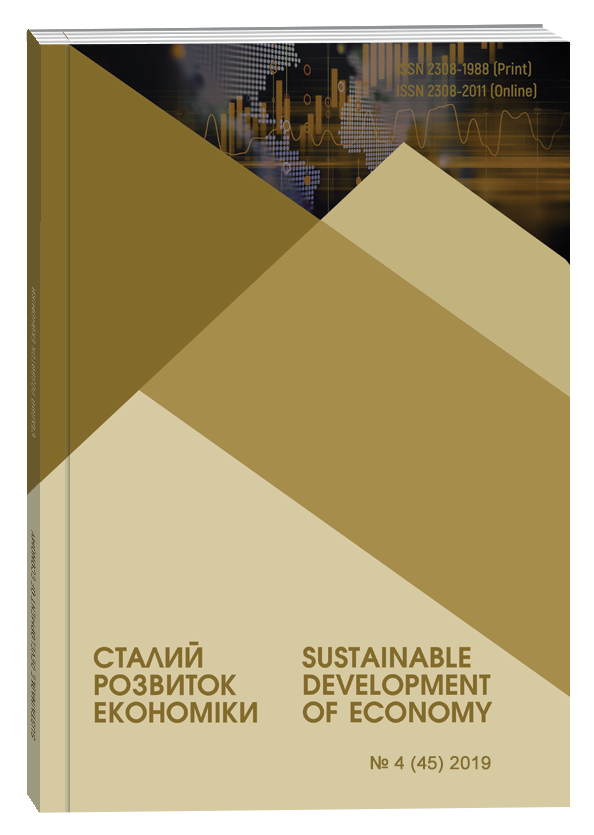CONDITIONS AND TRENDS OF INTERNAL TOURISM DEVELOPMENT IN UKRAINE
Abstract
Purpose. The aim of the article is the analysis of the state and dynamics of domestic tourism development in Ukraine using quantitative economic analysis tools. Methodology of research. General scientific and special research methods are used in the article, including the following: formalization (to calculate the growth rate of key indicators characterizing inland tourism in Ukraine (number of domestic tourists, number of collective accommodation facilities, average life expectancy, foreign direct investment in Ukraine, costs states for infrastructure development and capital investment in tourism, inflation); analysis and synthesis (for research, substantiation of visible relationships between indicators induction and deduction (to address issues related to domestic tourism development in Ukraine). Findings. The growth rates of indicators representing the development of domestic tourism in Ukraine are calculated: the number of domestic tourists, the number of collective accommodation facilities, the average life expectancy, foreign direct investment in Ukraine, the state's spending on infrastructure development and capital investment in the tourism sector, inflation. The tendency of the development of these indicators is monitored and results obtained are analyzed and substantiated. Originality. Scientific provisions on the characteristics of domestic tourism development in Ukraine have been further developed based on the use of correlation analysis and calculation of growth rates of indicators. Practical value. The results of the study can be used in the process of correlation analysis of the impact of individual indicators (number of collective accommodation units, average life expectancy, foreign direct investment in Ukraine, state spending on infrastructure and capital investment in tourism, inflation) on the increase in the number of domestic tourists in Ukraine, as well as forecasting the internal flow in the future.
References
Байда Б.Ф. Системний підхід до розвитку менеджменту туризму. Вчені записки ТНУ імені В.І. Вернадського. Серія: Економіка і управління. 2019. Том 30(69). № 2. С. 22-25.
Герасименко В.Г. Теорія туризму як складова туризму. Вісник соціально-економічних досліджень. 2011. № 12. C. 163-170. URL: http://nbuv.gov.ua/UJRN/Vsed_2011_2_30 (дата звернення: 28.10.2019).
Державна служба статистики України. URL: http://ukrstat.gov.ua (дата звернення: 28.10.2019).
Юринець З.В. Дослідження конкурентного середовища ринку туристичних послуг України. Ефективна економіка. 2015. № 1. URL: http://www.economy.nayka.com.ua/?op=1&z=3759 (дата звернення: 28.10.2019).
Arezki R., Cherif R., Piotrowski J. Tourism Specialization and Economic Development Evidence from the UNESCO World Heritage List. URL: https://www.imf.org/external/pubs/ft/wp/2009/wp09176.pdf (дата звернення: 28.10.2019).
Borzyszkowski J. Destination Management Organizations (DMO) – nowoczesne struktury organizacyjne w turystyce. Nowe wyzwania gospodarki turystycznej na poziomie lokalnym, regionalnym i międzynarodowym. 2011. S. 236-256.
Pearce P.L. Tourist Behaviour: themes and conceptual schemes. Clevedon: Channel View Publications, 2008. 241 p.
UNCTAD World Investment Report 2015. URL: http://unctad.org/en/PublicationsLibrary/wir2013overview_ru.pdf (дата звернення: 28.10.2019).
World Tourism Organization. URL: http://www.world-tourism.org (дата звернення: 28.10.2019).
Yurynets Z., Bayda B., Petruch O. Country’s economic competitiveness increasing within innovation component. Economic Annals – XXI. 2015. № 9-10. P. 32-35.
Baida, B.F. (2019), “Systems approach to development of tourism management”, Vcheni zapysky TNU imeni V.I. Vernadskoho. Seriia: Ekonomika i upravlinnia, Volume 30(69), no. 2, pp. 22-25.
Herasymenko, V.H. (2011), “The theory of tourism as a component of tourism”, Visnyk sotsialnoekonomichnykh doslidzhen, no. 12, pp. 163-170, available at: http://nbuv.gov.ua/UJRN/Vsed_2011_2_30 (access date October 28, 2019).
Derzhavna sluzhba statystyky Ukrainy [State Statistics Service of Ukraine], available at: http://ukrstat.gov.ua (access date October 28, 2019).
Yurynets, Z.V. (2015), “Research of the competitive environment of the tourist services market of Ukraine”, Efektyvna ekonomika, no. 1, available at: http://www.economy.nayka.com.ua/?op=1&z=3759 (access date October 28, 2019).
Arezki, R., Cherif, R. and Piotrowski, J. (2009), “Tourism Specialization and Economic Development Evidence from the UNESCO World Heritage List”, available at: https://www.imf.org/external/pubs/ft/wp/2009/wp09176.pdf (access date October 28, 2019).
Borzyszkowski, J. (2011), “Destination Management Organizations (DMO) – nowoczesne struktury organizacyjne w turystyce”, Nowe wyzwania gospodarki turystycznej na poziomie lokalnym, regionalnym i międzynarodowym, pp. 236-256.
Pearce, P.L. (2008), Tourist Behaviour: themes and conceptual schemes, Channel View Publications, Clevedon, England, 241 p.
UNCTAD World Investment Report 2015, available at: http://unctad.org/en/PublicationsLibrary/wir2013overview_ru.pdf (access date October 28, 2019).
World Tourism Organization, available at: http://www.world-tourism.org (access date October 28, 2019).
Yurynets, Z., Bayda, B. and Petruch, O. (2015), “Country’s economic competitiveness increasing within innovation component”, Economic Annals – XXI, no. 9-10, pp. 32-35.


